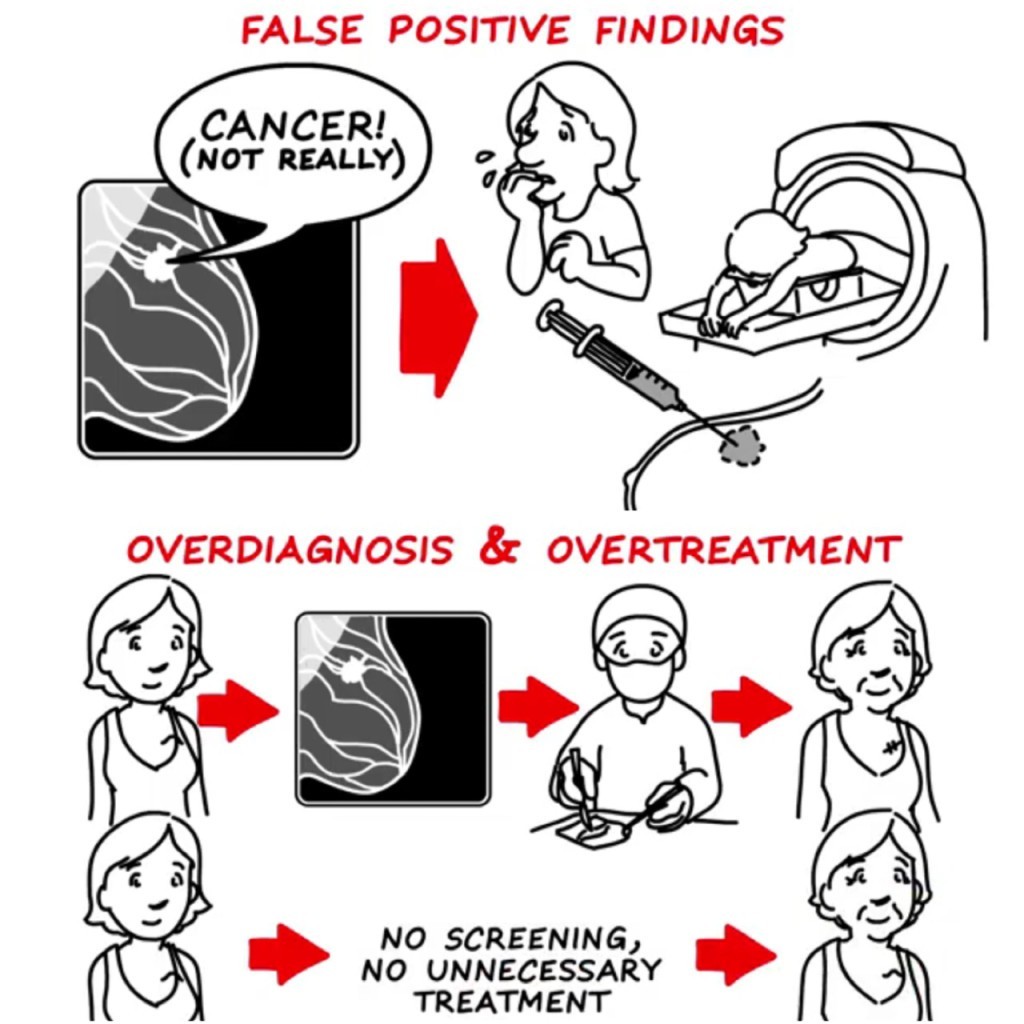Fifteen years ago, a major report from the British medical journal, The Lancet, collected data from seven different studies concluding that mammograms do not prevent women from dying of breast cancer or reduce the number of mastectomies. Fifteen years later, mammograms continue to be the most recommended test for breast cancer prevention.
The Cochrane review1 on screening mammography and an accompanying editorial2 published in the October 20, 2001 issue of the Lancet have created an emotionally charged stir in the medical business and many responses to try to control the damage. (See “Playing with Women’s Lives” by Spyros Andreopoulos in the Wednesday 12/19/01 San Francisco Chronicle and “Changing Medical Advice” in Wednesday 12/26/01 San Francisco Chronicle).
A systematic review of the randomized trials of mammography by the highly respected Nordic Cochrane Center came to the conclusion “that there is no reliable evidence that screening for breast cancer reduces mortality,” and “that screening leads to more aggressive treatment.” Many other highly respected researchers have come to similar conclusions. In 1995 Dr. Charles Wright, Clinical Professor, Department of Health Care and Epidemiology at the University of British Columbia, reported in the Lancet 3 his conclusions after reviewing the data: “Since the benefit achieved is marginal, the harm caused is substantial, and the costs incurred are enormous, we suggest that public funding for breast cancer screening in any age group is not justifiable.”
Prior to this, writing in a 1989 edition of the British Medical Journal, M. Maureen Roberts,4 clinical director of the Edinburgh Breast Cancer Screening Project since 1979, stated that, “We can no longer ignore the possibility that screening may not reduce the mortality in women of any age, however disappointing this may be, I believe that a rethink is required before the program goes any further. I feel sad to be writing this; sad because naturally after so many years I am sorry that breast cancer screening may not be beneficial, I am also sad to seem to be critical of the many dear and valued colleagues I’ve worked with over the years, particularly those who have made such a magnificent contribution to the care and welfare of women with breast cancer. But they will recognize that I am telling the truth.” Ms. Roberts’ article was published posthumously after her death from breast cancer.
“Since the benefit achieved is marginal, the harm caused is substantial, and the costs incurred are enormous, we suggest that public funding for breast cancer screening in any age group is not justifiable.”
–Dr. Charles Wright, Clinical Professor, Department of Health Care and Epidemiology at the University of British Columbia
The reason mammography fails is because it is a crude technique that most often finds cancer in the breast only after it has been growing there for 8 to 12 years. By this time, if it is truly cancer, it has spread to other parts of the body, beyond the reach of surgery and/or radiation. Unfortunately, our methods of dealing with disease that has spread – chemotherapy and hormone therapy – are of limited benefit.
Beyond the billions of health care dollars fruitlessly spent, what are the real harmful effects of mammography for a woman? Fear and anxiety surrounding this test take a toll on her daily life. Once an abnormality is found on a mammogram she will likely have surgery. In eight out of ten cases the lump is not cancer, so surgery was unnecessary. If she is diagnosed with cancer her whole world changes: she can no longer get life or health insurance, a career may no longer be available, and now everyone worries about “the breast cancer victim.” Furthermore, if the tests and treatments really do add little to a woman’s chance of surviving, then think of all the unnecessary costs, pain, and suffering caused by surgery, radiation, and chemotherapy — and all the disappointment that follows false hope.

A quick history on screenings: When mass screening was first introduced in the United States in 1973, it included women ages 35 and older. A more careful analysis of the data, however, revealed that mammography made no significant difference in survival in women under 50. Three years later, the recommendation was modified to apply only to women 50 or older. The change was prompted by a concern that the cumulative X-ray doses associated with mammography could cause breast cancer, and may take almost as many lives as it saves. Accordingly, revised recommendations issued again in 1976 called for a baseline mammography screening for women between the ages of 35 to 40, and an annual mammogram for women over 50. In 1983, the experts decided that the annual mammogram should now be employed in women 40 or older because new technology had reduced the radiation dose required to provide satisfactory mammograms to approximately one-third the dose delivered in the 1970s.
The burden of proof lies with those who recommend tests and treatments. If you believe that the Cochrane review, Charles Wright, Maureen Roberts, and many other respected researchers are correct in their position that “screening for breast cancer with mammography is unjustified,” then it is way past the time when we should have brought this universal medical practice in line with the scientific evidence. Unfortunately, I believe politics, pride, fear of medical malpractice suits, and billions of lost dollars will allow this behemoth to continue to trample over the health and welfare of women. Finally, for my colleagues, I paraphrase Maureen Roberts, “But you will recognize that I am telling the truth.”
What should a woman conclude? Individuals should put their efforts into a healthful diet and lifestyle in order to prevent breast cancer. For those interested in the subject will find a thorough discussion of mammography in the book The McDougall Program for Women.
References:
- Horton R. Screening mammography — an overview revisited. Lancet 358:1284-85, 2001.
- Olsen O, Gotzsche P. Cochrane review on screening for breast cancer with mammography. Lancet 358:1340-2, 2001.
- Wright C. Screening mammography and public health policy: the need for perspective. Lancet346:29, 1995.
- Roberts M. Breast screening: time for a rethink? BMJ 299:1153, 1989.
- Charatan F. News–US panel finds insufficient evidence to support mammography. BMJ; 324:255. 2002.
- Wells J. Newspaper reporting of screening mammography. Ann Intern Med 135:1029-37, 2001.
Links to above:
The Report:
http://thelancet.com/journal/vol358/iss9290/full/llan.358.9290.original_research.18001.1
Medical Expert Panel for the National Cancer Institute:
http://bmj.com/cgi/content/full/324/7332/255
Electronic Letters:
http://bmj.com/cgi/eletters/323/7319/956
“Playing with Women’s Lives” by Spyros Andreopoulos in the Wednesday 12/19/01 San Francisco Chronicle
http://www.sfgate.com/cgi-bin/article.cgi?file=/chronicle/archive/2001/12/19/ED147120.DTL
“Changing medical advice” in Wednesday 12/26/01 San Francisco Chronicle
http://www.sfgate.com/cgi-bin/article.cgi?file=/chronicle/archive/2001/12/26/ED144228.DTL
Read More:
The True Fight Against Breast Cancer by Pamela Popper, PhD.
Plant-based Diets For Breast Cancer Survival


























August 15, 2017
Had mammograms and ultrasounds for dense breast tissue. There was a spot they could never determine what it was and decided to just watch. Thankful to God, nothing developed further after 4 years of watching. However, interestingly enough, the spot went completely away after adapting Whole Food Plant eating. I believe if we eliminate Dairy and Animal Proteins, we eliminate progression of breast and prostate cancers. This opinion is supported by medical evidence.
October 25, 2016
In September 2010, the New England Journal of Medicine, one of the most prestigious medical journals, published the first study in years to examine the effectiveness of mammograms. Their findings are a far cry from what most public health officials would have you believe.The bottom line is that mammograms seem to have reduced cancer death rates by only 0.4 deaths per 1,000 women—an amount so small it might as well be zero. Put another way, 2,500 women would have to be screened over 10 years for a single breast cancer death to be avoided.
October 25, 2016
As a breast cancer survivor, I agree and disagree with the analysis that mammograms are harmful. I had ten “clean” mammograms in ten years, then found a lump. It was not visualized on mammogram, though it was the size of a grape. My breast surgeon said it could have been growing for 5-10 years. She said about 30% of women are “mammo occult”, meaning mammograms do not pick up their cancers. However! Non-invasive ultrasounds do. My lump lit up like a lightbulb on US. Mammos pick up one kind of cancers, ultrasounds another. I certainly think the protocol should be changed, perhaps rotating mammo one year, ultrasound the next (which would reduce radiation exposure by 50%). I know many women who have had their cancers detected with mammos, so they are absolutely life-saving. As for prevention? That needs to be the big conversation. After my diagnosis, my whole family went whole plant vegan. We have never felt better. I always thought we ate a healthy diet before, never ate junk food, lots of whole grains, veggies etc… I believe eliminating meat and dairy is crucial to staying healthy.
December 17, 2016
I think people are missing the point…once a cancer is detectable it has been there for at least ten years, so a mammo is not a good diagnostic for early cancer! You instantly become a coveted patient and any lump that shows cellular changes is treated aggressively as a cancer when in reality it would never have advanced, autopsies show many people die with long standing cancers, which is why diet is so crucial. It is an industry like any other, avoid it if you can. Despite the brush off, x-rays are carcinogenic and screening for cancer with a cancer causing agent makes about as much sense as treating cancer with cancer causing agents.
October 19, 2016
Tell this to the person who’s had their life saved by a mammogram — me.
And note that all the articles cited are 14 or more years old.
In particular, I challenge this statement:
“The reason mammography fails is because it is a crude technique that most often finds cancer in the breast only after it has been growing there for 8 to 12 years.”
Everyone should have facts to make their own decision, and articles like this neglect the other side of the story. Potentially a dangerous article.